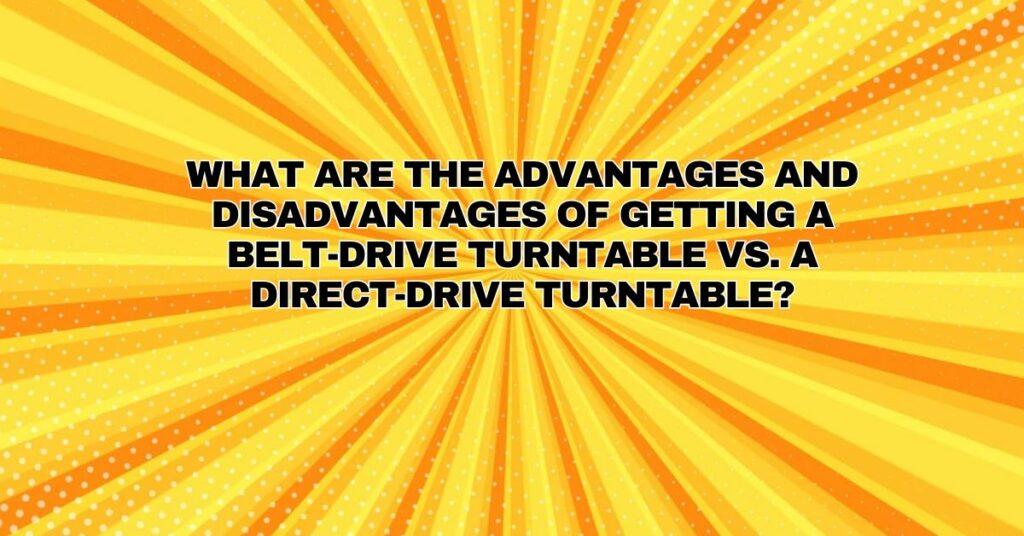The choice between a belt-drive turntable and a direct-drive turntable is a significant decision for vinyl enthusiasts and audiophiles. Each type offers distinct advantages and disadvantages, catering to different preferences and use cases. In this article, we will explore the characteristics, merits, and drawbacks of both belt-drive and direct-drive turntables to help you make an informed choice that aligns with your musical aspirations.
Belt-Drive Turntables: Advantages and Disadvantages
Belt-Drive Turntable Advantages:
- Sound Quality: Belt-drive turntables are celebrated for their superior sound quality. The belt mechanism isolates the platter from motor vibrations, resulting in cleaner audio reproduction with finer detail and reduced distortion.
- Reduced Motor Noise: The indirect transmission of motion in belt-drive systems minimizes motor noise, creating a quieter listening experience. This feature is especially appreciated during soft passages in music.
- Gentler Handling of Records: The separation between the motor and platter in belt-drive turntables is gentler on vinyl records. The reduced vibrations and absence of direct motor contact contribute to extending the lifespan of your cherished records.
- Analog Aesthetics: Belt-drive turntables are known for their analog aesthetics and tactile engagement. Handling a vinyl record and cuing the stylus onto the grooves are part of the charming ritual of vinyl playback.
- Audiophile Appeal: Many high-end audiophile turntables employ belt-drive mechanisms, emphasizing their commitment to sound quality and precision. These turntables often feature advanced engineering for enhanced audio fidelity.
- Simpler Design: Belt-drive turntables typically have a simpler design compared to direct drive models. This simplicity can translate into increased reliability and easier maintenance.
Belt-Drive Turntable Disadvantages:
- Maintenance: Belts in belt-drive turntables may require occasional replacement due to wear and aging. While this maintenance is relatively straightforward and inexpensive, it is an ongoing consideration.
- Start-Up Time: Belt-driven turntables may take a brief moment to reach their intended speed after you initiate playback. While this slight delay is inconsequential for most listeners, DJs and those who require instant start/stop capabilities may find it less suitable.
Direct-Drive Turntables: Advantages and Disadvantages
Direct-Drive Turntable Advantages:
- Instant Start/Stop: Direct-drive turntables offer instant start and stop capabilities, making them ideal for DJs and situations where precise control and quick transitions between tracks are essential.
- High Torque Motor: Many direct-drive turntables are equipped with high torque motors that can maintain consistent speed even under the resistance of heavy DJ scratching.
- Durability: Direct-drive mechanisms are generally considered more durable and less prone to mechanical wear compared to belts. This makes them well-suited for heavy and continuous use.
- Pitch Control: Direct-drive turntables often feature pitch control sliders or buttons, allowing DJs to adjust the playback speed for beat matching and mixing.
Direct-Drive Turntable Disadvantages:
- Motor Noise: The direct connection between the motor and platter can result in motor noise being transmitted to the stylus and the record. This may lead to increased background noise during playback.
- Reduced Sound Quality: While direct-drive turntables can deliver excellent sound quality, some audiophiles argue that belt-drive models have a slight edge in terms of audio fidelity and subtlety of detail.
- Less Gentle on Records: Direct-drive turntables, in some cases, may transmit more vibrations to the record due to the motor’s proximity to the platter. This can potentially lead to increased record wear over time.
Choosing the Right Turntable for You
The decision between a belt-drive and a direct-drive turntable ultimately hinges on your priorities and use case. Consider the following factors:
- Sound Quality: If you prioritize sound quality and have a discerning ear, a belt-drive turntable may be the better choice.
- DJing and Scratching: For DJing and scratching, a direct-drive turntable’s instant start/stop capabilities and high torque motor are advantageous.
- Record Preservation: If preserving your vinyl collection is paramount, a belt-drive turntable’s gentler handling of records is appealing.
- Maintenance: Be prepared to replace belts periodically with belt-drive turntables, while direct-drive models may require less frequent maintenance.
In conclusion, both belt-drive and direct-drive turntables offer unique advantages and disadvantages. Your choice should align with your listening preferences, intended use, and appreciation for the nuances of vinyl playback. Ultimately, the “best” turntable is the one that resonates with your musical journey and satisfies your audio desires.


